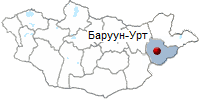 |
Barun-Urt town. Sukhbaatar aimag. Region of Mongolia. Baruun Urt. Erdenemandal Khiid. Shiliin Bogd Uul.
THE REGIONS OF MONGOLIA
SUKHBAATAR AIMAG.
BARUN-URT


Sukhbaatar aimag is situated in the eastern part
of Mongolia. The territory is hilly, predominantly steppe. The average altitude
is 3,281 - 3,937 feet (1,000 - 1,200 m) above sea level. The highest mountains
are Shiliin Bogda (5,830 feet /1.777 m) and Munkh Khan (5,249 feet /1.600 m).
Basalt covering of dead volcanos stretches as far as 3,861 square miles (10.000
sq. km) in the South - East of Sukhbaatar aimag.
The administrative center of Sukhbaatar aimag is the city of Baruu-Urt,
located 346 miles (557 km.) from Ulaanbaatar. Population 17,000. Elevation 981m. Baruun Urt is a scruffy, dusty and sometimes rowdy town in the middle of absolutely nowhere. Most people live in large ugly apartment blocks and work in a new Chinese-invested zinc mine, or in another coal mine 7km to the north-west. The water in Baruun Urt has high levels of sulphur so you are better off buying bottled water or filtering the tap water. Some maps refer to the town as
Sukhbaatar, which is confusing because this is the name of the capital of
Selenge aimag.
- If you are stuck in Baruun Urt, the museum in the dusty southern part of town is worth a look. It has a reasonable collection of costumes representing the three ethnic groups that inhabit the region: the majority Khaikh, Dariganga (30,000 live in the
South of Sukhbaatar aimag) and Uzemchin (about 2000 live in Dornod aimag and Sukhbaatar aimag). Look out for the interesting Uzemchin wrestling jacket.
There are also fine examples of products from Dariganga's renowned silversmiths and blacksmiths, some stuffed gazelle (which is probably about as close as you will ever get to one), a map showing the locations of the
'man' and 'woman' balbal statues in the aimag and some memorabilia of
Sukhbaatar.
- Erdenemandal Khiid. According to the monks at the monastery, Erdenemandal Khiid was originally built in 1830, about 20km from the present site. At the height of its splendour, there were seven temples and 1000 monks in residence, but the Stalinist purges of 1938 had the same result as elsewhere.
INFORMATION:
PAGES OF THE PICTURE ALBUM
|
|
 |
|